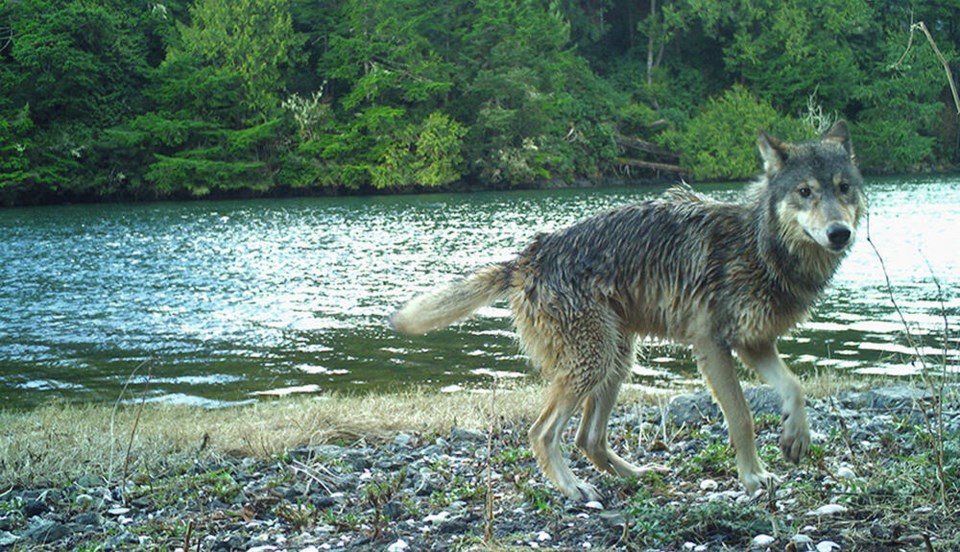TOFINO — In all of Joe Martin’s 68 years of living on the west coast of Vancouver Island, he said he’s only encountered a wolf once.
Martin recalled when a pack of wolves ran past him over 20 years ago while he was alone in the forest just outside the Tla-o-qui-aht First Nation community of Esowista.
Stopped in his tracks, he turned around to get another look, but the wolves had disappeared into the forest.
Martin said the experience is still vivid in his mind.
Like Martin, Tla-o-qui-aht First Nation Tribal Parks project co-ordinator Terry Dorward has only seen a wolf once in his life.
“We try to keep our worlds separate from them,” he said. “We try to create the space for them to flourish. It helps with keeping a healthy ecosystem intact.”
Besides their spiritual and cultural significance within Nuu-chah-nulth communities, wolves also play a vital role in the ecosystem, said Todd Windle, co-ordinator of Parks Canada’s Wild About Wolves project.
“Wolves are the top predator that we have in our ecosystem on Vancouver Island,” he said. “They’ll even hunt bears for food.”
Entering a wolf’s territory and seeing one of the animals is a privilege, said Windle. “It also comes with a responsibility to treat wildlife with the respect that they deserve to survive in their own habitat.”
Parks Canada launched the Wild About Wolves project in 2018 because of an increase in human interactions with the animals, Windle said. “It was not a healthy balance.”
When interactions become more frequent, the animals start to become too comfortable with people.
“That’s when you start seeing them in the middle of the day, or in a parking lot, or beside the road,” he said. “They’re actually seeking food — that’s an unhealthy type of observation.”
Since the program began, Windle said there has been a decline in the number of interactions with wolves.
Teachings from traditional knowledge holders from seven different First Nations, including Tla-o-qui-aht, are incorporated into the program. These include lessons on coexisting with wolves and the greater ecosystem, Windle said.
Remote cameras have been set up to collect data on how to protect wolves, prey species and other animals that wolves are in competition with — such as cougars.
Wolf scat is being collected to study their diet, and surveys are being conducted to better understand the attitudes, beliefs and values that drive people’s behaviour around wolves.
Windle said he hopes greater understanding of wolves helps people develop more respect for the animal, noting keeping dogs on-leash and not feeding wolves, either directly or indirectly, helps to protect them. “Doing what we can to prevent habituation, or having them become desensitized or less wary around people, is what keeps them safe.”
For several decades leading up to the 1960s, when predators in most parts of North America were seen as nuisances, wolves were eliminated from Vancouver Island.
At the time, Windle said, campaigns to remove predators by killing them were common. “It’s a little hard for us to think about now because it’s not how we are in society anymore.”
Wolves started naturally re-establishing themselves on Vancouver Island in the early 1970s, swimming from mainland British Columbia to the northeast part of the Island.
Since then, they’ve slowly migrated farther south and from the east to the west coast of Vancouver Island, and the number of interactions with humans has increased, Windle said.
“A lot of people hadn’t been living wolves for decades,” he said. “They were not in a position where they knew how to coexist with wolves, or maybe they needed to re-learn.”
Dorward recalled being taught not to video-record wolves by his late-uncle.
“We shouldn’t go out looking for them,” he said. “We shouldn’t go out trying to take their picture because what happens is that they’ll become habituated.”
Dorward said he was taught to say a prayer when entering the forest to acknowledge that he was stepping into the animals’ traditional territory. “We ask for protection,” he said. “And [share] that we come in peace.”
Windle said anyone encountering wolves should give them at least 100 metres of space, and report the sighting so Parks Canada can come up with strategies to help prevent the situation from getting worse.
“Sometimes there’s a misconception that if somebody reports a sighting or interaction, somebody’s going to come out and shoot the animal,” he said. “And that’s just not true. The more information we have, and the earlier we have that information, the better.”
— Ha-Shilth-Sa



